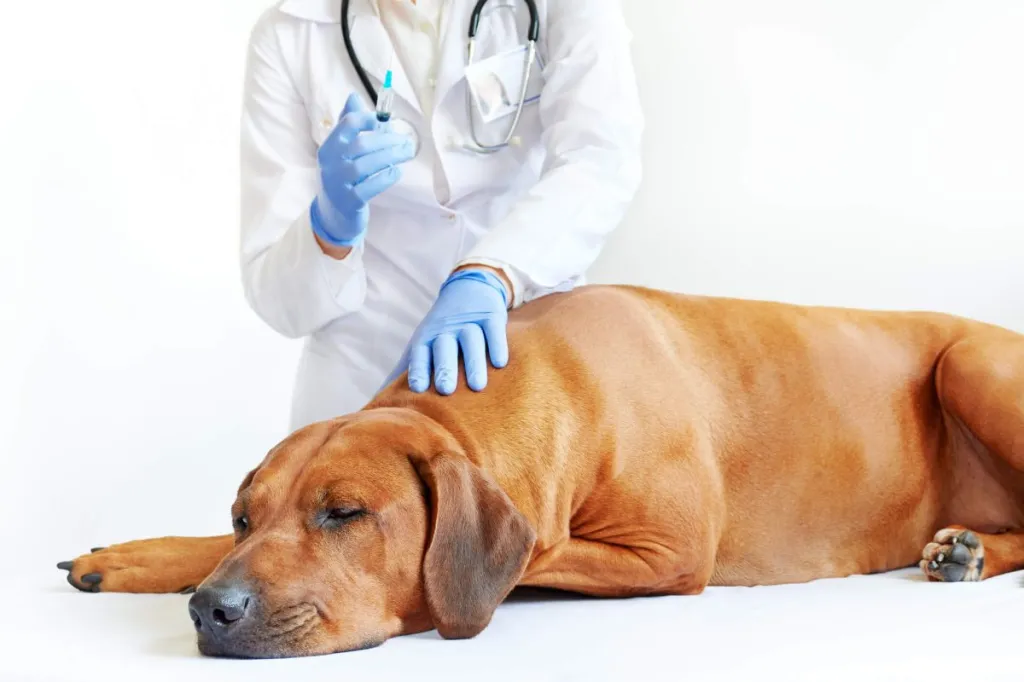Xylazine — also known by its brand name Rompun® — is a drug used as a sedative, analgesic, and muscle relaxant in dogs. Initially developed for use in large animals like horses and cattle, it has also proven to be effective in canines. As an alpha-2 adrenergic agonist, xylazine works by depressing the central nervous system to induce a calming effect. This medication is particularly useful in situations where a dog needs to remain still or calm during diagnostic tests, minor surgical procedures, or treatments that could otherwise cause anxiety or discomfort.
Here’s what you should know about xylazine’s uses, dosage, and side effects for dogs.
Uses of xylazine for dogs
Xylazine is often used in dogs for a variety of clinical purposes, including:
- Sedation for minor procedures: Xylazine can be given to dogs to calm them down and facilitate minor medical procedures like wound cleaning, bandaging, or diagnostic imaging.
- Pre-anesthetic medication: Before undergoing surgery, dogs may be given xylazine to induce a relaxed state and make the transition to general anesthesia smoother.
- Pain management: Due to its analgesic properties, it is sometimes used to manage moderate pain, particularly when combined with other pain-relieving drugs.
- Muscle relaxation: For conditions requiring muscle relaxation, such as certain types of seizures or muscle spasms, xylazine can be beneficial.
Xylazine is available in two formulations: a 20 mg/mL concentration in 20 mL vials and a 100 mg/mL concentration in 50 mL vials. Apart from Rompun®, it is sold under several other brand names, such as Gemini®, AnaSed®, and Sedazine®.
Dosage of xylazine for dogs

The following is a guideline for the typical use of the drug in dogs and must not replace your vet’s advice for your individual pet.
The dosage of xylazine varies depending on the size, weight, and medical condition of your dog. Your vet will administer the drug via injection, either intramuscularly (IM) or intravenously (IV). Generally, the dosage ranges from 0.25 to 0.5 mg per pound (0.5 to 1 mg/kg) when given IV or 0.5 to 1 mg per pound (1 to 2 mg/kg) when administered IM. Xylazine’s effects generally begin within 10-15 minutes and can last for up to one to two hours. However, this may vary for each dog.
After receiving Rompun®, your dog will become more relaxed and may appear sleepy. This is normal and indicates that the medication is taking effect. Depending on the dose and your dog’s individual response, they may remain in this sedated state for a while, allowing the vet to perform the necessary procedures without causing your dog stress. Sometimes, despite being fully sedated, your dog may still react to sharp auditory stimulation by moving, kicking, biting, or scratching.
In cases of xylazine overdose or if the sedative effects need to be quickly reversed, your vet may administer an alpha-2 adrenergic antagonist such as yohimbine or atipamezole. These agents can effectively counteract the sedative and cardiovascular effects of xylazine, allowing your dog to regain normal function more rapidly.
Side effects of xylazine for dogs
While xylazine is generally safe and effective, it is not without risks. Some common side effects in dogs include:
- Bradycardia (slowed heart rate)
- Vomiting
- Respiratory depression
- Hypotension (low blood pressure)
- Hyperglycemia
- Pain at the site of injection
- Muscle tremors
Because of these potential side effects, Rompun® should be used with caution in dogs with pre-existing conditions. This includes heart diseases, severe liver and kidney problems, breathing issues, or diabetes. It should not be administered to dogs with known hypersensitivity to the drug. Additionally, its use is contraindicated in dogs who are pregnant, nursing, or severely debilitated.
It is important to note that xylazine may interact with other central nervous system depressants, antihypertensive drugs, and certain antibiotics. These include barbiturates, epinephrine, prochlorperazine, some narcotics, and acepromazine. Always inform your vet about any other medications your dog is taking.
Once your dog has been sedated with xylazine, you’ll need to monitor them closely during the recovery period. Your vet will provide specific aftercare instructions to ensure your dog returns to normal safely. Make sure to follow these guidelines and report any unusual behaviors or symptoms to your vet immediately.









